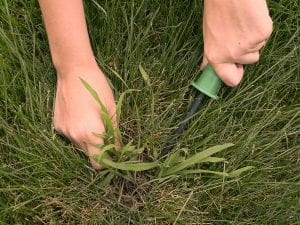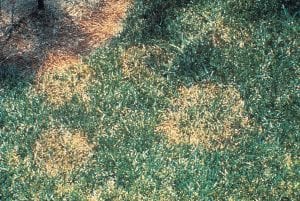We all dream of having that perfect lawn. You know the type – where the grass is full and brilliant green. A carefully maintained lawn can make your home look better and even increase its value.
Sadly, all too often grass can suffer from disease and harmful conditions, even when cared for meticulously. All sorts of problems can arise, from weeds to lawn diseases, that can affect the lawn that you’ve worked so hard to achieve. It’s time to figure out, once and for all how to address these lawn problems, so you can fully enjoy a healthy and vibrant lawn.
Weeds In Your Yard
One of the easiest problems to identify on your lawn is when weeds start popping up. Perhaps the most common is the dandelion, a weed that is marked by the prominent yellow flower that looks like a puffball. This pervasive weed can take over what would normally be an immaculate lawn.
Other common weeds that can grow in your yard include crabgrass, nutsedge, white clover, and broadleaf plantain. Weeds are pesky and thrive in a variety of conditions, so controlling them is no easy feat. That’s where weed control comes in.
Lawn Weed Treatment and Solutions
A weed control plan is critical. Weeds damage your yard by competing with healthy grass for moisture, nutrients, light, and space. Therefore, eliminating weeds means helping your lawn grow.
So what is involved in a weed control program? There are a number of elements you’ll want to pay close attention to. Proper fertilization, mowing, and irrigation encourage grass to grow quickly and prevent weed growth. Never mow more than 1/3 of your grass’s height at a time, and irrigate your lawn with 1/3 inch of water every other day between 6 and 10 am.
Most broadleaf weeds, like dandelions and chickweed, can be controlled by letting your grass grow longer. Choosing a higher mowing setting will help limit the amount of sunlight these weeds receive.
Beyond that, a post-emergent treatment will put a stop to existing broadleaf weeds, such as dandelions, clover, and thistle. However, there may still be seeds left in the soil, so any new growth can be treated on a spot basis.
The timing of your weed treatment can also make a difference. Crabgrass, for example, is a grassy weed that is best controlled in the spring, right before the weeds germinate. Crabgrass germination typically occurs when the soil is above 65 degrees Fahrenheit, so getting pre-emergent services complete before this temperature hits is key. While hot and dry weather encourages crabgrass, well-maintained and properly fertilized lawns that are watered and mowed regularly will prevent crabgrass from growing.
In short, the right weed treatment program will not only get rid of current weeds but stop new ones from growing.
Lawn Diseases
Weeds aren’t the only thing that can have an impact on your lawn. Even with them out of the way, your yard can still be hit with lawn disease.
Five of the most common lawn diseases include brown patch, dollar spot, rust, leaf spot, and fairy ring. Let’s take a look at each one.
Brown patch
Brown patches are a type of grass fungus that pops up in the summer on cool-season grasses. These large discolored patches can grow several feet wide and are caused by fungus in high temperatures. If left unchecked without proper grass fungus treatment, brown patches can kill large areas of grass quickly.
Dollar spot
This disease can be identified by white or beige lesions on the grass blades, which appear in circles no more than 6 inches wide throughout the lawn. Dollar spot can kill both warm-season and cool-season grass.
Rust
This disease will cause a yellowish discoloration in grass blades, which eventually turns to a rusty color (as the name suggests). Warm-season grasses in soils that are moist and low in nitrogen are most susceptible to rust, which can cause lawns to thin and die out.
Leaf spot
This causes grassroots to rot in summer, leaving dark lesions on the individual grass blades. As the weather becomes increasingly hot and dry, infected areas of the lawn will “melt-out” and die.
Fairy ring
This disease occurs when a circle of mushrooms surrounds an area of grass. These rings are usually several feet wide, and the grass inside the circle is often darker than the rest of the lawn. This disease will sometimes kill the grass inside the ring, as water often has trouble reaching the roots.These are the most common diseases you may encounter on your lawn. Lawn diseases can become a serious problem, so putting a stop to them is of vital importance. That’s why you should implement a lawn disease and lawn fungus control program.
Seasonal Lawn Diseases
When it comes to lawn disease and fungus control for lawns identifying the problem affecting your grass is the first step. Discolored and spotted grass leaves could be a sign of lawn disease. Problems like leaf spots, snow mold, and spring dead spot are caused by fungi.
If you find lesions on your grass blades – particularly during cool weather – certain parts of your lawn might have leaf spots. In the summer months, the fungi will infect the blades, spread to the base of the grass, and ultimately kill it. The fungi will need to be removed through fungus control for lawns to protect your yard and keep it healthy.
Snow mold is a fungus that develops in wet, cool weather and can be destructive under snow or following a prolonged rainfall. While raking matted spots will encourage circulation and encourage lightly infected areas to repair themselves, significantly affected areas may require reseeding.
Serious snow mold infections can result in the crown and root rotting, which can lead to widespread lawn damage and disease. Bermuda grass is susceptible to spring dead spot. Also caused by fungi, this disease can rot both shoots and roots and is manifested as brightened dead spots as the grass emerges from dormancy.
Fungus Control for Lawns and Treatment
The best ways to prevent lawn disease is to keep your lawn healthy, through proper mowing, watering, and fertilizing. Specific diseases may require a modified lawn fungus treatment approach as well. Fungicides, for example, will help stop the spread of brown patches. In the case of Dollar spot, which can be spread by contact, lawn irrigation can help aid in prevention. Irrigation and applying a fertilizer with high nitrogen levels will also help stop rust, while aerating, fertilizing, and watering deeply and infrequently will help prevent diseases like leaf spot and fairy ring.
If lawns are suffering from one or more disease, it’s important to get started on fixing it immediately with weed treatment and fungus control for lawns. Waiting will only make the problem worse. With this knowledge of how to best address lawn weeds and disease control, you’re well on your way to having that beautiful yard you’ve always wanted.
Not sure if your property is suffering from lawn weeds, disease or fungus? Call Lawn Doctor today for a free evaluation.


